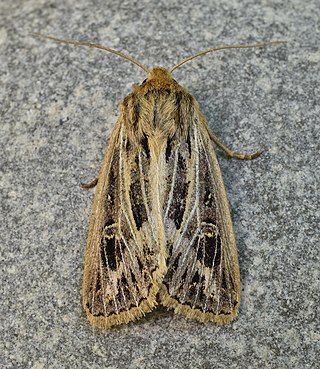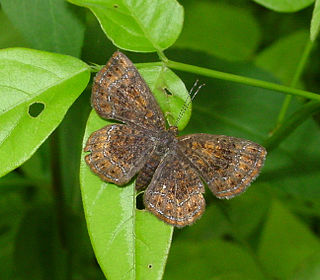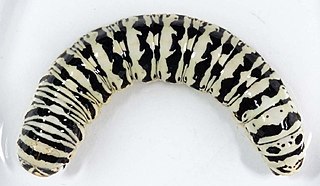
Kalmia polifolia, previously known as Kalmia glauca and commonly called bog laurel, swamp laurel, or pale laurel, is a perennial evergreen shrub of cold acidic bogs, in the family Ericaceae. It is native to north-eastern North America, from Newfoundland to Hudson Bay southwards.

Hemaris thysbe, the hummingbird clearwing, is a moth of the family Sphingidae (hawkmoths). Coloration varies between individuals, but typically the moth is olive green and burgundy on its back, and white or yellow and burgundy on the underside. Its wings are transparent with a reddish-brown border. It has light-colored legs, which combined with the lack of striping on the underside is diagnostic. Beating its wings rapidly, H. thysbe hovers to collect nectar from a variety of flowers. The combination of its appearance and its behavior commonly leads to it being confused with a hummingbird or bumblebee.

Citheronia sepulcralis, the pine-devil moth, is a Nearctic member of the family Saturniidae and of the subfamily Ceratocampinae. The species are blackish brown. The species was first described by Augustus Radcliffe Grote and Coleman Townsend Robinson in 1865.

Hemaris gracilis, the slender clearwing or graceful clearwing, is a moth of the family Sphingidae. The species was first described by Augustus Radcliffe Grote and Coleman Townsend Robinson in 1865.

Acronicta lanceolaria, the lanceolate dagger moth or pointed dagger, is a moth of the family Noctuidae. The species was first described by Augustus Radcliffe Grote in 1875. It is found in North America, from Nova Scotia to British Columbia. It is listed as a species of special concern and believed extirpated in the US state of Connecticut.

Copivaleria is a monotypic moth genus of the family Noctuidae erected by Augustus Radcliffe Grote in 1883. Its only species, Copivaleria grotei, or Grote's sallow, was first described by Herbert Knowles Morrison in 1874. It is found in eastern North America, including Ontario, Tennessee, New York and Maryland.

Coranarta is a genus of moths in the family Noctuidae.

Apamea niveivenosa, the snowy-veined apamea, is a moth of the family Noctuidae. The species was first described by Augustus Radcliffe Grote in 1879. It is native to northern North America, where it can be found across Canada and south to California.

Apamea plutonia, the dusky Quaker or dusky apamea, is a moth of the family Noctuidae. The species was first described by Augustus Radcliffe Grote in 1883. It is native to northern North America, where it occurs across the boreal regions, with some occurrences from as far south as New Mexico and Pennsylvania.

Catocala badia, the bay underwing, bayberry underwing or old maid, is a moth of the family Erebidae. It is found from southern Maine and New Hampshire south to New York and Connecticut.

Syngrapha epigaea, the pirate looper moth or narrow silver Y, is a moth of the family Noctuidae. The species was first described by Augustus Radcliffe Grote in 1874. It is found from coast to coast in Canada south in the east to Pennsylvania, Ohio, and the northern Great Lakes states.

Acronicta falcula, the corylus dagger moth, is a moth of the family Noctuidae. The species was first described by Augustus Radcliffe Grote in 1877. It is found in the United States and Canada from southern New England to southern Manitoba and Iowa. Recently seen from Wisconsin, Connecticut, Rhode Island, New York and Michigan. It is reported as rare in Ohio. It is listed as a species of special concern in the US state of Connecticut.

Paraseptis is a monotypic moth genus in the family Noctuidae erected by Tomas Mustelin and Lars G. Crabo in 2015. Its only species, Paraseptis adnixa, was first described by Augustus Radcliffe Grote in 1880. It is widely distributed along the Pacific Coast from northern Mexico to south-western British Columbia in a variety of forested habitats.
Drasteria hudsonica, the northern arches, is a moth of the family Erebidae. The species was first described by Augustus Radcliffe Grote and Coleman Townsend Robinson in 1865. It is found from Alaska and Yukon to California, east to New Mexico and Manitoba.

Euphyes bimacula, the two-spotted skipper, is a butterfly of the family Hesperiidae. It is found in North America, from northeast Colorado and western Nebraska; eastern Nebraska east to southern Quebec; southern Maine south to central Virginia; coastal plain south to Georgia; and the Gulf Coast.

Calephelis borealis, commonly known as the northern metalmark, is a butterfly of the family Riodinidae. It ranges through western Connecticut south through west-central Pennsylvania; central Appalachians and Ohio River Valley. Isolated populations are also found in southwest Missouri and eastern Oklahoma. The habitat consists of open woodland streams near serpentine, shale or limestone barrens.
Sympistis dentata, the toothed apharetra moth, is a moth of the family Noctuidae described by Augustus Radcliffe Grote in 1875. It is found from Yukon, the Northwest Territories, and British Columbia to Newfoundland and the northern United States, south in the east to New Jersey. It is listed as threatened in the US state of Connecticut.

Cucullia speyeri, common names Speyer's paint, Speyer's cucullia or Speyer's hooded owlet moth, is a moth found in North America. It is found from Alberta and Montana to the Atlantic coast from New Hampshire to Virginia. It was described by Joseph Albert Lintner in 1874. In the US state of Connecticut, it is listed as a species of special concern and is believed to be extirpated. The habitat consists of open meadows, dry grasslands and native prairies.

Dargida rubripennis, the pink streak, is a species of moth in the family Noctuidae. It was described by Augustus Radcliffe Grote and Coleman Townsend Robinson in 1870. It is found in the eastern United States, ranging to Kansas and Texas. It is listed as threatened in the US states of Massachusetts and Connecticut. The wingspan is 32–37 mm.
Euxoa violaris, the violet dart moth, is a species of moth native to North America. It is listed as a species of special concern in the US state of Connecticut. It was described by Augustus Radcliffe Grote and Coleman Townsend Robinson in 1868.














